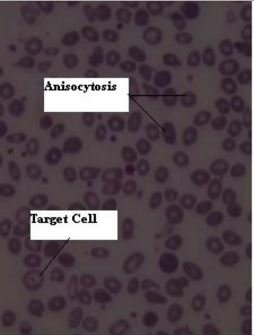Anisocytosis
Anisocytosis Definition
Anisocytosis is a medical condition characterized by abnormal sized red blood cells. The sizes of the red blood cells are not similar to each other. These uneven sizes of red blood cells are caused by different blood disorders like anemia, thalassemia, from blood transfusions or from vitamin deficiencies. Anisocytosis is diagnosed by a blood smear preparation in a diagnostic lab. [1, 2, 3, 5]

Symptoms
The vital function of red blood cells is to transport oxygen and nutrients to different tissues of the body. These provide energy to all tissues so they can work accordingly.
Usually the sizes of the RBC’s are equal and they efficiently hold and carry oxygen / nutrients. In anisocytosis, the RBC’s are not of equal size and due to this reason the efficiency of holding and carrying of oxygen / nutrients is diminished and this affects the whole body system. [2, 3, 5]
People with anisocytosis often feel the following symptoms [2, 3, 5]:
- Exhaustion with little effort, lack of energy
- Mild physical activity also causes tiredness
- Dyspnea or shortness of breathing
- Hypoxia –is a condition in which an area of the body or tissue is deprived of sufficient oxygen
- Tachycardia- increased heart rate
- Pale skin, nails and eyeballs from decreased blood flow
- Body temperature is lower than normal
- Cold palms and feet
- Headache
- Vertigo
Causes
Erythropoiesis (development of RBC’s) originates in red bone marrow. The kidneys secrete erythropoietin which is a hormone that stimulates red bone marrow for production of RBC’s. Factors such as vitamin B12, folic acid and iron help to mature the RBC’s.
In anisocytosis, the RBC’s are under developed and the following reasons may promote the condition [2, 5]:
1. Deficiency of Folic acid
- Lack of vitamin A which the body needs to fight infection and it also leads to irregular sized RBC’s.
- Folic acid is essential for synthesis of DNA, which has a vital role in cell maturation and cell division. Deficiency of folic acid leads to abnormal and diminished DNA and consequently failure of nuclear maturation and then RBC’s differ in size.
2. Deficiency of Vitamin B12
The function of vitamin B12 is similar to folic acid. Vitamin B12 which is secreted from the gastric glands helps to absorb nutrients with the help of intrinsic factors. Deficiency of vitamin B12 leads to immature RBC’s and poor absorption of essential nutrients like folic acid and iron.
3. Pernicious anemia
An abnormality is in the gastric mucosa that fails to produce normal gastric secretions and thus fails to produce intrinsic factors. In absence of the intrinsic factors, vitamin B12 is unable to work properly.
4. Liver disease
After absorption of vitamin B12 from the GI tract, it is first stored in the liver and then released by the bone marrow. In liver disease, storage and discharge of vitamin B12 is abnormal.
5. Kidney disease
In case of a degenerative condition, the kidneys are unable to secrete the erythropoietin hormone which inhibits the red blood cell production.
6. Anemia
Anemia can be different in type but in all cases the amount of RBC’s and hemoglobin is less. The condition may arise due to lack of iron, vitamin B12 and folic acid.
7. Thalassemia
- It is a congenital genetic disorder where the bonding of protein sub-units, denoted as α subunit and β subunit hampering hemoglobin. Thalassemia leads to severe anemia and life threatening conditions.
- Bone marrow disorders can also lead to incorrectly sized RBC’s.
8. Blood Transfusion
People that go for blood transfusions often have anisocytosis because of the mismatch in the size of RBC’s from the donor blood to that of the recipient blood. The sizes of the RBC’s are an important factor which should be taken care of before transfusion of blood.
Diagnosis
For detection of anisocytosis it is essential to perform a blood smear.
Blood Smear Test
For a blood smear a thin film of blood is prepared by smooth spreading of blood on a slide with the addition of a dye. They wait until the thin film smear becomes dry and then that slide is examined under electronic microscope to determine the size of each red blood cell. This test helps to identify the abnormal size of the RBC’s.
After confirmation of anisocytosis, the reason of this disorder can be identified and then a routine diagnosis can be made. The tests are [2, 3]:
- T3, T4 and TSH levels, checking for thyroid gland functioning
- Hemoglobin estimation for detection of anemia
- Adrenal gland functioning
- Calcium testing
Treatment
Identification of the underlying cause is a vital part for anisocytosis as it is caused by different disease conditions. Anisocytosis does not have a usual treatment because it is not a condition but rather a symptom and the treatment of the underlying cause(s) can reverse the anisocytosis.
As early as the reason is determined, the treatment can be effective as the causation diseases are more fatal than the anisocytosis itself and the advanced stages of the underlying disease treatments are quite difficult and costly.
Supplementation of vitamin B12 and folic acid helps to reduce symptoms of anisocytosis due to deficiency of vitamin B12 or folic acid. [2, 3]
Reference List:
- GP Note Book, Available from: http://www.gpnotebook.co.uk/simplepage.cfm?ID=-1845100514
- HX Benefit, Available from: http://www.hxbenefit.com/anisocytosis-definition-causes-symptoms-diagnosis-and-treatment.html
- Right Diagnosis, Available from: http://www.rightdiagnosis.com/a/anisocytosis/intro.htm
- Wikipedia, Available from: https://en.wikipedia.org/wiki/Anisocytosis
- Wise Geek, Available from: http://www.wisegeek.org/what-is-anisocytosis.htm
